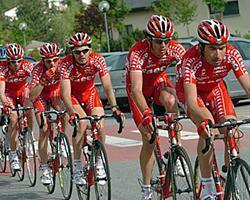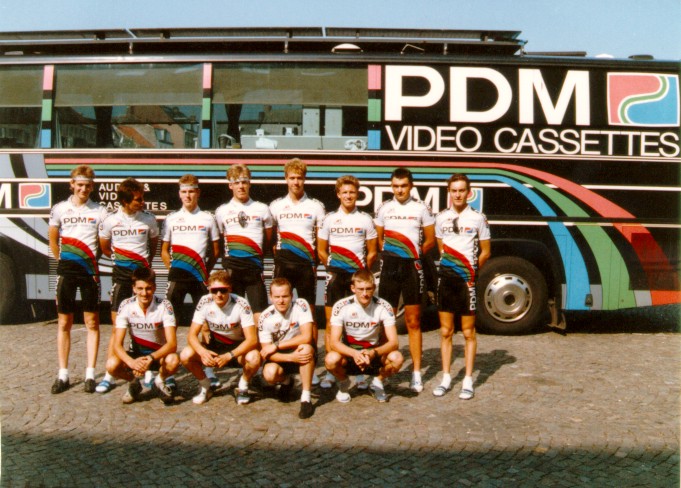February 15, 2011 by Irish Peloton
Doubling up with Yellow and Green
Although it’s still very early in the season, team managers will have most of their Tour de France team decided already. There may be room for one or two changes if particular riders show great signs of improvement over the coming months (or indeed, get injured). But in general, even if the team managers don’t announce it publicly, the majority of each nine man team for the Tour is already final.
The makeup of each Tour team depends on the goal of that team. For example, take the US Postal team of Lance Armstrong during his Tour winning reign. Each rider that was picked for the Tour de France was going there to sacrifice himself for the G.C. aspirations of their leader. There had been some decent sprinters on the US Postal squad throughout that time such as Julian Dean and Max van Heeswijk, but none of them ever got to ride the Tour due to the singular focus of the team. The Banesto teams of Miguel Indurain were similar. For those with such a fixation on General Classification, harbouring sprinters was not a great concern.

Mario Cipollini's Saeco sprint train (cyclingnews.com)
The same is not quite true when the situation is reversed. For teams that have a world class sprinter in their midst and want stage wins, there is still scope for certain riders to pursue G.C. ambitions. Consider the Saeco team of Mario Cipollini in the late nineties. That team perfected a sprint train used to launch Cipollini to nine Tour stage wins during his time there. But often, they placed a rider high on G.C. also. In 1997, when Cipollini won two stages of the Tour, his team mate Francesco Casagrande placed 6th overall. Improving in 1999, Cipollini won four stages and Laurent Dufaux managed fourth overall. More recently, in 2008, Team Columbia-High Road guided Mark Cavendish to four stage wins while placing Kim Kirchen eighth overall.
So it is possible to divide a team which harbours ambitions for both sprint stage wins and the yellow jersey. But has there ever been a Tour de France team to achieve the ultimate triumph of multi-tasking, a team that has won both the Yellow Jersey and the Green Jersey with two different riders?

1997 Tour de France podium - The last time that one team managed to win both Yellow and Green Jerseys (einestages.spiegel.de)
Since the re-introduction of trade teams in the Tour de France in 1969, this is a feat which has been achieved three times. The Telekom team managed to do it twice in a row in the mid-nineties. When Bjarne Riis won the Tour in 1996, his team mate Erik Zabel won his first of six Green Jerseys, although both riders have since confessed to using EPO to aid their efforts during this time. The following year, Jan Ullrich took over as Tour champion from team mate Riis, while Zabel continued his Green Jersey streak.
The only other time that this feat has been managed is back in 1977 when Bernard Thevenet won the Tour. Riding for Peugeot, Thevenet’s team mate Jacques Esclassan won the Green Jersey. Just like Riis and Zabel, after the fact, Thevenet admitted to using cortisone to help him to victory.
As for other feats of multi-tasking throughout this period, in 1986 Greg LeMond won the Tour and his La Vie Claire team mate Bernard Hinuault won the polka dot jersey and finished second. And in 1991, the Carrera team managed the rare feat of taking the Green Jersey and the Mountains Jersey through two different riders, Djamolidin Abdoujaparov and Claudio Chiappucci respectively.
A special mention must go the PDM team of 1989, who duplicated the achievements of the 1991 Carrera team by winning Green and Polka Dot through Sean Kelly and Gert-Jan Theunisse. But also won the sprints jersey, again through Kelly, and the combination classification through Steven Rooks. But despite winning four of the six available jerseys, the PDM team didn’t manage to get any of their riders on the podium. They did however finish in fourth (Theunisse), seventh (Rooks), eighth (Raul Alcala) and ninth (Kelly). A classic case of too many generals.

The (sort of) all conquering PDM team of 1989 (www.witpuntcom.nl)
In recent years, the closest any team has come to achieving the Yellow/Green double is Rabobank in 2008. Oscar Freire won the Green Jersey, the only Spanish rider ever to do so, while Denis Menchov finished the Tour in third (if we consider him to have been moved up a place after the elimination of Bernard Kohl).
So are any of the teams in the current peloton likely to come close to achieving this rare double? Well, Menchov has since moved on from Rabobank, where the Dutch rider Robert Gesink has taken over the reigns as G.C. leader. Gesink will likely challenge for a podium spot but Freire, who would probably not take part in the fight for Green Jersey points anyway, has indicated that he will not be riding the Tour, due to the fact that the focus will be solely on Gesink.
The main protagonists for the Green Jersey will likely be Mark Cavendish and Tyler Farrar. Both riders are on incredibly strong teams but neither of which have an outstanding candidate to challenge for the Maillot Jaune. Cavendish’s HTC-High Road team have the likes of Tony Martin and Peter Velits. Both of whom are capable of a top 10 finish, but no more. Farrar has the backing of one of the most enviable teams ever assembled but have no out and out Tour favourite. In Christian Vande Velde, Ryder Hesjedal and Christophe Le Mevel they have three riders who have all finished in the top 10 of the Tour before, but none of whom are likely to reach the podium let alone win the Tour.
Neither of the two outstanding favourites for the Tour, Andy Schleck or Alberto Contador will be sacrificing men to allow their teams to participate in the Green Jersey competition. Consequently, it could be a long while before we see a team win both the Yellow and Green Jerseys at the Tour again.


Leave a Reply